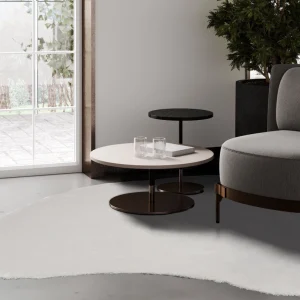THERE HAS BEEN welcome recalibration of our cultural landscape over the past few years, with institutions all over Europe seeking to redress the myopic, racist or misogynist attitudes of past centuries that saw little if any representation from women artists nor artists from outside our own geographic footprint (apart from the US).
 El Anatsui’s Afua’s Surviving Children sculptures, made in driftwood; Hew Locke’s Armada, a flotilla of vessels bearing decorative elements such as coins and badges; Yinka Shonibare’s colourfully dressed woman on a set of ornate steps. Image Credit: Thomas Adank
El Anatsui’s Afua’s Surviving Children sculptures, made in driftwood; Hew Locke’s Armada, a flotilla of vessels bearing decorative elements such as coins and badges; Yinka Shonibare’s colourfully dressed woman on a set of ornate steps. Image Credit: Thomas Adank
It was easier for those with big, international collections (such as the Tate Galleries) to instigate an almost immediate post #metoo, #blacklivesmatter shift, instigating wholesale rehangs that foregrounded artists of every gender, and from the global south and Asia or its diaspora alongside the usual white, male suspects. And the whiff of a new, ‘woke’ (and/or bargainhunting) collector base triggered a stampede from commercial galleries to represent the latest hot new talent from Lagos, Accra, Colombia or Cambodia. But smaller museums and galleries are only just beginning to demonstrate this shift, in their curation and thinking, since – as any of FX’s exhibition designer readers know – it takes at least two years to pull a serious show together.
But at this point in the narrative, galleries have to do more than simply hang a more diverse range of artists on the wall and say, ‘look, aren’t we enlightened?’ The problems have arisen through institutional and systemic practices and prejudices. For true representation, it’s important for museums to take the trouble to dig deeper and explain the toxic attitudes that lie embedded in their founding philosophies and funding. So hats off to the Royal Academy, which has done this rather well in its show Entangled Pasts: Art, Colonialism and Change. And that is thanks to its collaborative team of curators and designer Jayden Ali, of JA Designs.
Ali was part of the team that designed and programmed the celebrated British Pavilion at the Venice Architecture Bienniale of 2023. He also designed 2023’s highly praised Fashioning Masculinities show at the V&A. With this RA show, he and the guest curators have appraised the very white, patriarchal history that is visible – even embedded – within its walls and worked to create a dialogue that carries us through from the founding of the Academy in 1768 by Joshua Reynolds until today.
 El Anatsui’s Afua’s Surviving Children sculptures, made in driftwood; Hew Locke’s Armada, a flotilla of vessels bearing decorative elements such as coins and badges; Yinka Shonibare’s colourfully dressed woman on a set of ornate steps.
El Anatsui’s Afua’s Surviving Children sculptures, made in driftwood; Hew Locke’s Armada, a flotilla of vessels bearing decorative elements such as coins and badges; Yinka Shonibare’s colourfully dressed woman on a set of ornate steps.
I have always thought of the best exhibition design as inspired choreography – using the objects, the themes and the available architecture to pace and persuade the visitor, drawing us up close to observe details, and packing a heart-stopping punch when required. Ali’s approach here combines some very simple, minimal rooms interwoven with big set pieces. The first of these is the opening gallery, into which he has inserted a striking bust of a black man, sculpted in the classical style, and set on a plinth in the centre of the room. Says Ali: ‘I encountered this amazing bust by Francis Harewood at the Getty (Museum) about ten years ago and it was always included in the (proposal for the) show but we made the suggestion to situate this bust at the centre of the room… Standing at the centre of a space as a black person is a moment of empowerment and strength but it comes with its own inherent fragility that exists in the moment of occupation. So in this instance, this magnificent, handsome man is accompanied by his friends.’ What Ali is referring to are the portraits of black people arranged on the walls around him, some by contemporary artists (Kerry James Marshall’s reimagining of 18th-century former slave turned artist Scipio Moorhead), but most of them historic, including Gainsborough’s 1768 portrait of Ignacio Sancho, actor, writer, composer and the first man of African descent to vote in Britain. Ali says: ‘This is rare: I’ve never stepped into a room where you just have black figures at the centre.’ A masterstroke in this black-walled room is how Ali has treated the busts of venerable white artists that look down from a set of ceiling alcoves, framed in gold – Michelangelo and Da Vinci among them. There were eight, but he has reduced the number and placed large, mirrored panels over a few at intervals, so that as we look up to these near deities, we see ourselves reflected back. Given the unusually diverse and atypical crowd gathered for the show’s opening, according to Ali, this was a fantastic way of demonstrating the diversity in the room.
 El Anatsui’s Afua’s Surviving Children sculptures, made in driftwood; Hew Locke’s Armada, a flotilla of vessels bearing decorative elements such as coins and badges; Yinka Shonibare’s colourfully dressed woman on a set of ornate steps. Image Credit: Veronica Simpson
El Anatsui’s Afua’s Surviving Children sculptures, made in driftwood; Hew Locke’s Armada, a flotilla of vessels bearing decorative elements such as coins and badges; Yinka Shonibare’s colourfully dressed woman on a set of ornate steps. Image Credit: Veronica Simpson
The subsequent gallery, themed Sites of Power: Conflict and Ambition, is more conventional in one respect – mostly historic paintings, arranged along the walls, by the 18th-century ‘masters’ representing the power and might of British aristocracy (clients made rich by the growth of the slave trade and colonial plantations) and the British navy, the tool by which they wielded that power. But into the centre of this room, at waist height, the team has inserted Guyanese- British artist Hew Locke’s Armada, a flotilla of colourful vessels bearing decorative elements such as coins, badges and replica medals, that suggest their role as ‘votive’ offerings.
Beyond this are rooms that show crosscultural influences on artists of both colonised and colonising countries, another reveals works by 18th-century European painters asked to represent the colonies as idylls, interwoven with works that demonstrate anything but (Yinka Shonibare’s colourfully dressed woman kneeling on a set of ornate steps, or Karen McLean’s Primitive Matters: Huts, which foregrounds simple Trinidadian workers dwellings against a slide show of opulent colonial mansions).
About two-thirds of the way round there is one atmospheric, cinematic room surrounded by deep, blood-red velvet drapes in which Isaac Julien’s powerful anti-slavery film Lessons of the Hour plays – suddenly, the voices of those who have suffered are in the foreground. But the room beyond this is the most breathtaking: with darkened, deep blue walls it features the haunting soundtrack and scenes from black British artist John Akomfrah’s anti-whaling, anti-slavery film Vertigo Sea (revealing, frame by frame, man’s inhumanity to mammal). Next door to this is Ghanaian artist El Anatsui’s stunning parade of bruised and battered refugees, Afua’s Surviving Children, conjured in driftwood El Anatsui fished out of the Danish sea, and carved and scorched by the artist into this haunting procession. Set against the flaming anger of Frank Bowling painting Middle Passage, it’s as if the sun is setting on this tragic scene. And indeed there is joy in the following two rooms, filled with Lubaina Himid’s colourful characters (100 cardboard cut-outs, the outfits and postures of which demonstrate their slave status on one side, while short caption on the back offer up their ‘real’ names and identities).
At the end of our tour, Ali says: ‘ I think what we are really good at is giving the objects space to say what they need to say – and respecting and knowing what that is.’ I’d second that.





